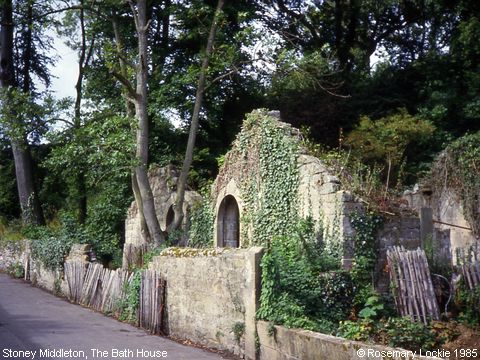The Bath House, Stoney Middleton
These “twin” Bath Houses look a bit different now! This photograph was taken just before the Parish Council (with the help of a grant from the Peak National Park Authority) initiated their renovation. This building was constructed originally by Thomas DENMAN in 1815 and is served by warm spring water arising naturally. Thomas was “Lord of the Manor” and lived at Stoney Middleton Hall, and the construction of the Bath House was part of his refurbishment of the Hall, and in-keeping with building programmes amongst the aristocracy of the time, but also provided to serve the needs of his workers and tenants. It replaced an earlier building; indeed, bath houses on this site are believed to be traceable back to Roman times, or even earlier. Thermal waters are a product of meeting of the two sedimentary rocks, limestone and gritstone, which characterise the Peak, and the Celts are believed to have built a shrine to their goddess Arnemetia here. Later, when the Romans discovered it, they would no doubt have built one of their 'infamous' bath-houses here too. In the Middle Ages also it is said that the springs served a bath-house where according to tradition, a Crusader was cured after returning home with leprosy. As a thanksgiving he built a well chapel, and dedicated it to St Martin, the patron saint of cripples. The present church, built nearby, retains the old chapel's dedication to St Martin. During the 18th Century the baths were visited for relief of rheumatism and treatment of eye disorders. There were then three warm springs feeding an open bath, enclosed by a high wall. The present building contains two rectangular baths, one for ladies and one for gents. They measure about 10ft by 14ft by 5ft deep, with access by means of a set of stone steps. Each has a small outer changing room, reached from the outside, a fireplace in one corner and a window in the outer wall. The naturally warm spring water surfaces at a constant 63 degrees Fahrenheit through the floor of the ladies' bath, passing from there into the gentlemen's bath after which it is piped out towards the brook. Sounds quite luxurious, doesn't it, but one can imagine it could be quite claustrophobic! As to what it might have been like in its heyday, there is also a less well known single Bath House in a nearby wood, built similarly to serve an adjacent Hall, which has a similar appearance, and is fed by a similar warm spring. It had a ‘window’, and steps leading down into the water and at the time I knew it was more complete than the Bath House at Stoney Middleton, and still holding its supply of running water (although the window was unglazed - and apparently had always been so. The water filling it really was warm, and steamed gently amidst the woodland shade, but it was rust coloured, and had a distinct metallic smell (probably the result of leaching iron from the soil). This could have been the result of the spring arising elsewhere and being channelled to the bath, and pollution of the water course over the years, but its appearance didn't really invite one to bathe inside! The water was so murky I've no idea how deep it really was, but for as much as I could tell, it could have been any depth from 5 feet to 50! (Information provided by Rosemary Lockie) References
Image contributed by Rosemary Lockie in June 1985.
|
||
